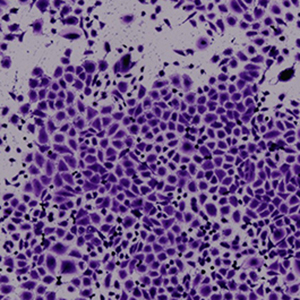The role of miR-143-3p/FNDC1 axis on the progression of non-small cell lung cancer

Submitted: 12 October 2022
Accepted: 22 March 2023
Published: 3 May 2023
Accepted: 22 March 2023
Abstract Views: 653
PDF: 339
HTML: 19
HTML: 19
Publisher's note
All claims expressed in this article are solely those of the authors and do not necessarily represent those of their affiliated organizations, or those of the publisher, the editors and the reviewers. Any product that may be evaluated in this article or claim that may be made by its manufacturer is not guaranteed or endorsed by the publisher.
All claims expressed in this article are solely those of the authors and do not necessarily represent those of their affiliated organizations, or those of the publisher, the editors and the reviewers. Any product that may be evaluated in this article or claim that may be made by its manufacturer is not guaranteed or endorsed by the publisher.
Similar Articles
- Chaoyong Tian, Yang Yang, Yao Li, Fei Sun, Juan Qu, Dingjun Zha, Expression and localization of α2A-adrenergic receptor in the rat post-natal developing cochlea , European Journal of Histochemistry: Vol. 67 No. 3 (2023)
- Sheila Veronese, Ezio Costa, Antonella Portuese, Riccardo Ossanna, Andrea Sbarbati, Histological analysis of the dermal and hypodermal layers of the face and correlation with high-frequency 24 MHz ultrasonography and elastosonography , European Journal of Histochemistry: Vol. 68 No. 2 (2024)
- CarloAlberto Redi, Essentials of apoptosis - A guide for basic and clinical research , European Journal of Histochemistry: Vol. 54 No. 1 (2010)
- F Cappello, C Tripodo, F Farina, V Franco, G Zummo, HSP10 selective preference for myeloid and megakaryocytic precursors in normal human bone marrow , European Journal of Histochemistry: Vol. 48 No. 3 (2004)
- K Smetana, Structural features of nucleoli in blood, leukemic, lymphoma and myeloma cells , European Journal of Histochemistry: Vol. 46 No. 2 (2002)
- The Scientific Committee, Proceedings of the 68th Congress of the Italian Embryological Group-Italian Society of Development and Cell Biology (GEI-SIBSC) - Oliveri, 5-8 June 2023 , European Journal of Histochemistry: Vol. 67 No. s3 (2023): Proceedings of the 68th Congress of the Italian Embryological Group-Italian Society of Development and Cell Biology (GEI-SIBSC) - Oliveri, 5-8 June 2023
- CarloAlberto Redi, Male germ line stem cells: Developmental and regenerative potential , European Journal of Histochemistry: Vol. 55 No. 4 (2011)
- F Di Meglio, D Nurzynska, C Castaldo, A Arcucci, L De Santo, M de Feo, M Cotrufo, S Montagnani, G Giordano-Lanza, In vitro cultured progenitors and precursors of cardiac cell lineages from human normal and post-ischemic hearts , European Journal of Histochemistry: Vol. 51 No. 4 (2007)
- M. Malatesta, M. Giagnacovo, L.V. Renna, R. Cardani, G. Meola, C. Pellicciari, Cultured myoblasts from patients affected by myotonic dystrophy type 2 exhibit senescence-related features: ultrastructural evidence , European Journal of Histochemistry: Vol. 55 No. 3 (2011)
- G Giuffrè, V Barresi, A Catalano, A Cappiello, F Stagno d’Alcontres, G Tuccari, Actinic keratosis associated with squamous and basal cell carcinomas: an evaluation of neoplastic progression by a standardized AgNOR analysis , European Journal of Histochemistry: Vol. 52 No. 1 (2008)
<< < 56 57 58 59 60 61 62 63 64 65 > >>
You may also start an advanced similarity search for this article.

 https://doi.org/10.4081/ejh.2023.3577
https://doi.org/10.4081/ejh.2023.3577











